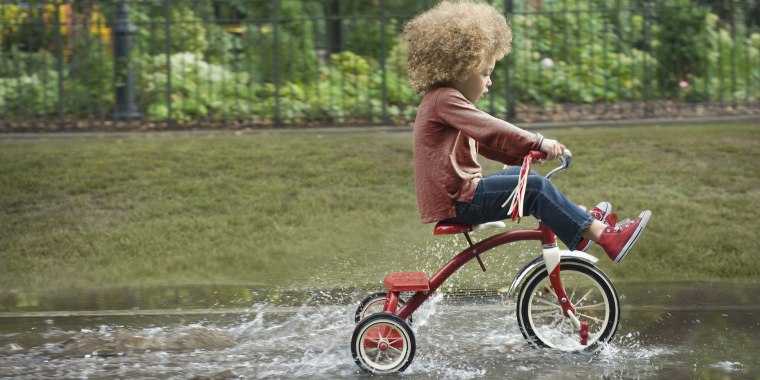For many children, starting pre-kindergarten marks their first introduction to structured daily school time. Children in pre-kindergarten are still developing both their gross motor skills, which involve whole-body movement, and their fine motor skills, which involve the coordination of small muscle movements. Below are guidelines on your preschooler's physical development. However, the information here is intended only as a general guide. If your child seems to be out of step in terms of physical development, you should consult your pediatrician.
Gross motor skills
Overview
You will observe your child's gross motor skills developing rapidly at this age, as their movements become more coordinated and your child learns to control their body more effectively. For example, they are beginning to walk up and down stairs confidently with one foot on each step, rather than the more hesitant, step-at-a-time approach your child took when they were younger. However, even as they are becoming more confident of their developing physical skills, children this age can still often overestimate their abilities. Tumbles and falls are common and are not a cause of concern unless your child seems unusually clumsy and falls more than their playmates.
Balance
Your child’s balance will improve significantly throughout this year. By the end of pre-kindergarten, your child should be able to balance on one foot for at least 10 seconds. Playing hopscotch helps develop this skill.
Hopping
Your child should be able to hop on one foot several times. Jumping rope helps develop this skill.
Walk forward and backward
Your child should be able to walk forward and backward on a straight line on the floor, or on a balance beam. Using playground equipment such as a climber's bridge helps to develop this skill.
Playground
Your child should be able to climb up and down playground equipment, swing, and use a slide with confidence.
Tip toes
Your child should be able to stand on tip toes with their hands held over their head for several seconds.
Walk on tip toes
Your child should be able to walk on tip toes. Excessive walking on tip toes can be a sign of certain developmental complications, but if your child is growing and developing normally there should be no cause for concern. Consult your pediatrician if you have questions.
Tricycle
Your child should be able to pedal and steer a tricycle with ease, and drive it in figure eights and circles.
Somersault
Your child should be able to do a somersault.
Throwing
Although your child's ability to play catch or kick a ball is still developing, your child should be able to throw a ball with reasonable accuracy at a target a few feet away. Your child should also be able to kick a ball with accuracy.
Skipping
Your child should be able to skip for around 15 feet.
Galloping
Your child should be able to gallop for around 15 feet.
Bicycle
As your child's balance improves, it may be time to have them try to ride a bike without training wheels. Although children learn to ride without training wheels at a range of ages, most parents start thinking about taking the training wheels off at around this age.
Fine motor skills
Overview
Your child's fine motor skills will be developing as quickly as their gross motor skills. One of the most important things you can do to help them develop these skills is to let them struggle from time to time to accomplish tasks, such as fastening buttons or cutting food. Only by repeated effort will your child learn how to do these things, and learning to handle frustration is also crucial for their emotional development.
Buttons
Your child should be able to button and unbutton their clothes by themselves and dress themselves when asked.
Utensils
Your child should be able to eat using utensils and, with supervision, to cut some food using a knife.
Scissors
Your child should be able to use scissors to cut along a straight line or cut out simple shapes.
Pencil
Your child should be able to hold a pencil or crayon with their fingers rather than their fist.
Straight lines
Your child should be able to draw straight lines.
Copy shapes
Your child should be able to copy circles, triangles, and squares.
String beads
Your child should be able to string beads on a string.
Play-Doh
Your child should be able to manipulate Play-Doh into round balls and elongated, snake-like shapes.
Building blocks
Your child should be able to build towers using building blocks.
Sleep
Overview
Restful sleep is a fundamental requirement for a healthy preschooler. It allows a rapidly growing body the opportunity to recharge and ensures that your child is prepared for the day ahead. Studies have shown that a well-rested child is alert, refreshed, and less susceptible to infection. In fact, a child’s misbehavior or hyperactivity is often a result of too little sleep. It is important to prioritize sleep by ensuring that your child has a dark, quiet, and comfortable bedroom and by establishing a regular nightly routine with your child before tucking them into bed. A child who is well-rested will wake up spontaneously and have energy throughout the entire day.
How much sleep?
A pre-kindergarten student needs 11 to 13 hours of restful sleep every day. Most are ready for sleep between 7 and 9 p.m. and will sleep until sometime between 6 and 8 a.m., depending on whether they are still napping. Children usually stop napping during the day by the age of 5.
Learn more about supporting your preschooler with our pre-K physical health tips and physical activity recommendations pages.
TODAY's Parenting Guides were developed by NBC News Learn with the help of subject-matter experts, including Dr. Natasha Burgert, Pediatrician, Pediatric Associates and Dr. Jayne Greenberg, District Director, Miami-Dade County Public Schools.



